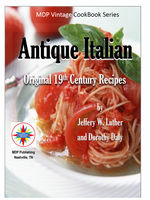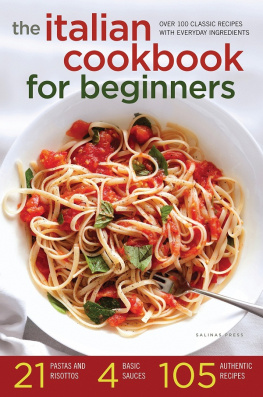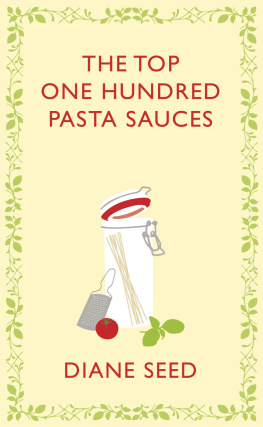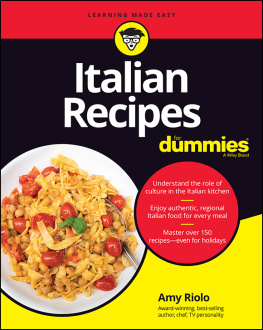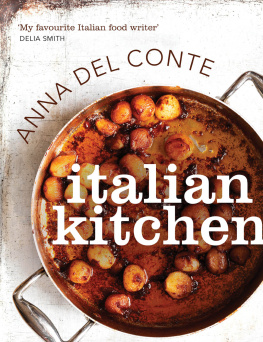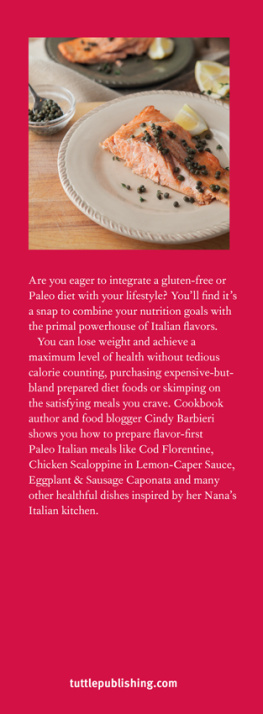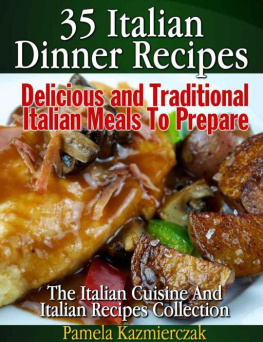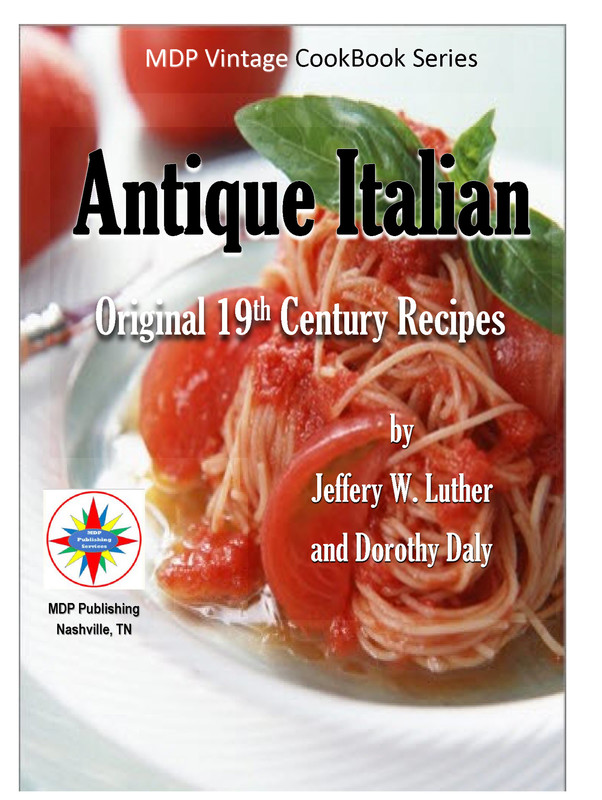
2016, MDP Publishing
Antique Italian: Original 19th Century Recipes by Jeffery W. Luther, Editor with Dorothy Daly. Published May 2016
Based on the book "Italian Cooking" by Dorothy Daly originally published in 1900 by Spring Books, Spring House, Spring Place, London NW 5 All Rights Reserved. No part of this publication may be reproduced, stored in a retrieval system, or transmitted in any form by any means, electronic, mechanical, photocopying, recording or otherwise, without express, prior permission of the Publisher. No responsibility is assumed by the Publisher or Authors for any injury and/or damage to persons or property as a matter of product liability, negligence or otherwise, or from any use or operation of any methods, products, instructions or ideas contained in the material herein.
ISBN: 978-1-944409-00-5 (EPUB & PDF Formats)

MDP Publishing
Nashville, TN
ANTIQUE ITALIAN
Original 19th Century Recipes
by
Jeffery W. Luther
with
Dorothy Daly

MDP Publishing
Nashville, TN
Table of Contents
ANTIQUE ITALIAN
Introduction by Dorothy Daly circa 1900.
Chapter 1: Some Useful Facts and Figures
Chapter 2: Flavourings, Trimmings, Herbs and Spices used in Italian Cookery
Chapter 3: Antipasti
Chapter 4 : Soups
Chapter 5: Pasta
Chapter 6: Ravioli & Gnocchi
Chapter 7: Rice
Chapter 8: Polenta
Chapter 9: Omelettes, Egg & Cheese Dishes
Chapter 10: Fish
Chapter 11: Meats
Chapter 12: Poultry & Game
Chapter 13: Vegetables
Chapter 14: Salads
Chapter 15: Sweets
Chapter 16: Sauces
Original Introduction by Dorothy Daly circa 1900.
Before thinking about Italian cooking, its as well to give some thoughts to the good foods native to that sunny country.
And before getting down to the food itself, give some consideration to what, in Italy, is its essential accompaniment good wine. From north to south whether one travels by road or by rail, one doesnt travel far without seeing stretches of vineyards, and from the delightful Soave, produced in the vicinity of Verona, to the slightly spicy Orvieto of the Umbrian Hills, down to the delicate Lachrima Christi with which the visitor to Naples, Pompeii and Amalfi is regaled, theres no excuse in Italy for stinting the wdne with which to cook or with which to eat the finished dish. Not all Italian wines travel well enough to allow them to be brought across to our own country, but a little patient exploration of the Italian wine shops of Soho will result in a fairly lengthy list of Italian wines that can be purchased here in England at a price sufficiently reasonable as to make it not an extravagance to use them when suggested in the recipe for a truly Italian dish, or to form the highly agreeable habit of taking a glass or two of Vino with ones Pasta or Ossobuco. Make the acquaintance of your Italian wine merchant; talk to him about his various wines, ask him to suggest good wines for certain dishes; get him talking about the different wines to be met with in different parts of his beloved country if hes a true Italian, his advice will be well worth taking, and the next time you visit his country you will order your wine by name, instead of mumbling something about half a bottle of that red stuff. And in spite of the long list of named varieties, your Italian wine merchant will probably point to the wisdom of buying a carafe of the local wine, for many of these local wines, though they do not travel well, are excellent when drunk in their own particular place of origin.
Not only is Italy a country of wines, it is also a country of cheeses, cheeses of a staggering variety. There is no need at all in Italy to ruin an otherwise perfect dish by the addition of two tablespoonfuls of grated mousetrap, nor is there any need in England nowadays to commit such a solecism when a fairly good range of Italian cheeses may be found in the best provision shops of most of our large towns. Where cheese for cooking is concerned, we may have to substitute Bel Paese, which travels well, for Mozzarella, which doesnt, and our own cream cheese for the Italian Ricotta which again doesnt care much for transportation, but where table cheeses are concerned, theres a wide variety from which to choose.
And what of the olive groves, where the silvery-grey leaves of the slender gnarled trees give an other-world appearance to the landscape? Small wonder that so many truly Italian dishes are built upon a foundation of either the fruit, green or ripened to blackness, or the oil extracted from the fruit of these trees and remember, the use of oil in cooking does not mean that the resulting dish will be oily only the badly cooked dish merits that adjective.
Wines, cheeses, olive oil, lemons, lemon juice and tomatoes (raw, cooked or rendered down into the puree or conserve we can now purchase in tooth-paste tubes that allow one to use a little without wasting the balance), green, red, yellow and variegated peppers, purple egg plants, artichokes, and zucchini are but a few of the colourful basic foods of the peninsula, but they are enough to go on with.
And why, so far, no word of pasta, that everpresent, ubiquitous Italian dish? For the reason that Pasta, whatever it may be to-day, is said not originally to have been a native of the country, but is alleged to be one of the many wonders brought home by the 13th century explorer, Marco Polo, from his travels in China. Nevertheless, although Pasta, in its many shapes and forms, may not have started off as a true native of Italy, to-day it seems as much a part of the country as an operatic tenor, and anyone wanting to present a truly Italian meal must perforce learn a few of the ways of preparing and cooking Pasta.
So much for the food and drink harvested from the land. What about the fruit of the seas that wash the shores of the long, indented coastline, all the strange and lovely fish and shellfish abounding in the waters? What of the colourful fish to be seen in the fish market in Venice, to mention but one of the famous markets? In most coastal towns of Italy fish is good and recipes for cooking it abound. English taste wont, of course, take kindly to all of them, and the mention of octopus may bring forth a horrified shudder, but few English men or women look askance at a dish of scampi or red mullet, and these are but two of a great number of delicacies piscatorial.
In the following pages an attempt has been made to offer to the English cook a selection of typical Italian dishes that can be cooked and enjoyed in her own country. It is a compilation rather than an invention, for to invent four hundred original Italian recipes would be not merely an impossible task but an insult to the established repertoire of Italian cooks.
Introduction
Cooking has always been a passion of mine. I've spent manys hours looking up recipes or reading about how to make some exotic dish, then spent countless more hours experimenting in the kitchen.
I've cooked my way around the globe by making dishes from Australia to Zimbabwe and every letter in between. Now that my wife and I are semi-retired, we have begun to travel to these places to be able to experience these cuisines first hand.
Next page
